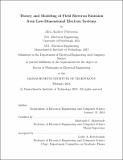Theory and modeling of field electron emission from low-dimensional electron systems
Author(s)
Patterson. Alex A. (Alex Andrew)
DownloadFull printable version (13.60Mb)
Other Contributors
Massachusetts Institute of Technology. Department of Electrical Engineering and Computer Science.
Advisor
Akintunde I. Akinwande.
Terms of use
Metadata
Show full item recordAbstract
While experimentalists have succeeded in fabricating nanoscale field electron emitters in a variety of geometries and materials for use as electron sources in vacuum nanoelectronic devices, theory and modeling of field electron emission have not kept pace. Treatments of field emission which address individual deviations of real emitter properties from conventional Fowler-Nordheim (FN) theory, such as emission from semiconductors, highly-curved surfaces, or low-dimensional systems, have been developed, but none have sought to treat these properties coherently within a single framework. As a result, the work in this thesis develops a multidimensional, semiclassical framework for field emission, from which models for field emitters of any dimensionality, geometry, and material can be derived. The effects of quantum confinement and emitter tip geometry on the properties of emission were investigated by utilizing the framework to derive models for: i) a highly-curved, nanoscale, metal emitter tip; ii) a bulk silicon emitter with a surface quantum well formed due to electric field penetration and a mechanism that limits the maximum conduction band emitted current density (ECD) to the bulk flux density supply; and iii) a cylindrical silicon nanowire emitter. Results from a highly-curved, nanoscale, metal emitter tip reveal that despite signicant electron supply reductions as a result of quantum confinement, the emitted current density (ECD) increases as the emitter radius decreases due to the effects of electric field enhancement. Additionally, emitters with radii smaller than 5 nm exhibit a narrow total energy distribution and highly non-linear FN plots. Consistent with experimental observations, the saturation of the conduction band ECD in silicon emitters leads to the appearance of three distinct regions in FN plots, which signify conduction-band-dominated, valence-band-dominated, and transitional regimes of emission. Confinement of electrons to a nanowire emitter geometry further reduces the electron supply available for emission and, consequently, the conduction band saturation ECD. Overall, findings show that the dimensionality, geometry, and material of field emitters all play a critical role in field emission processes at the nanoscale. Accordingly, the semiclassical framework for field emission is intended to form a solid foundation upon which more complete models of emission can be developed.
Description
Thesis: Ph. D., Massachusetts Institute of Technology, Department of Electrical Engineering and Computer Science, 2018. This electronic version was submitted by the student author. The certified thesis is available in the Institute Archives and Special Collections. Cataloged from student-submitted PDF version of thesis. Includes bibliographical references (pages 253-271).
Date issued
2018Department
Massachusetts Institute of Technology. Department of Electrical Engineering and Computer SciencePublisher
Massachusetts Institute of Technology
Keywords
Electrical Engineering and Computer Science.